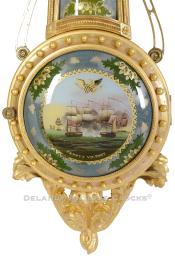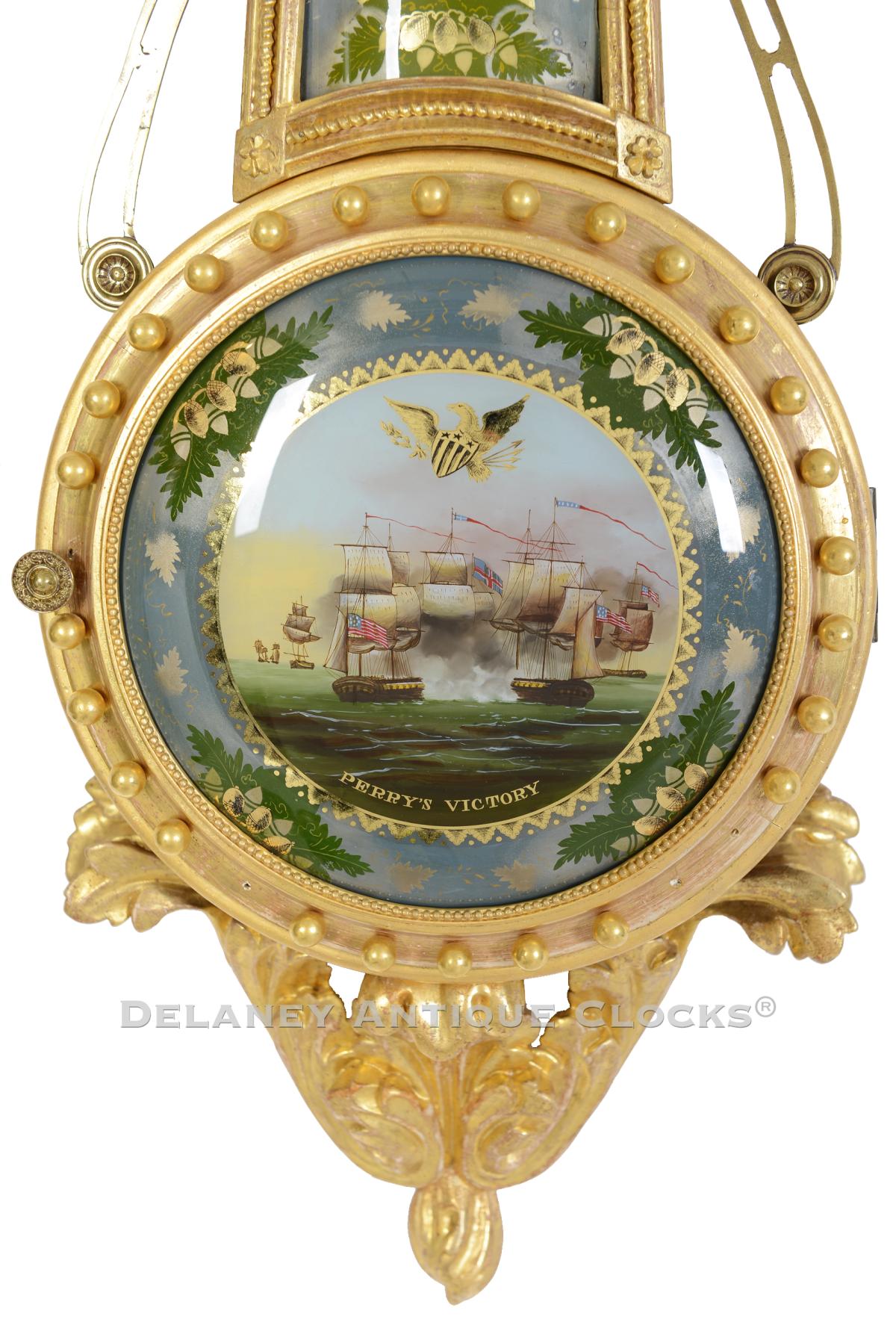Lemuel Curtis Girandole wall timepiece. 224116.
In 1802, Lemuel Curtis was an apprentice of the Willards and worked in Boston. In 1811, he moved to Concord and set up his shop as a Clockmaker. Curtis specialized in timepieces. Over the years, he made several improvements to Simon Willard's original patent design. One example is the single screw movement mounting system of mounting the movement to the case. His ultimate achievement would have been the design of this girandole form. However, this was not a financial success. As a result, a small number were originally produced. A small number of these are now in the collections of our Country's best Museums. Over the last century, reproductions of this beautiful form have been built by The Waltham Clock Company, Elmer Stennes, Ted Burleigh, and Foster Campos.
This first-period example's case, a testament to Lemuel Curtis's craftsmanship, measures forty-five inches long. It is constructed in mahogany and retains its original shellac finish on the sides. The frames, bezel, carved eagle finial, and bracket are wonderfully gilded in gold leaf. This work is expertly done and of the finest quality. The gilding is in excellent overall condition.
The reverse-painted convex or bowed glass tablets are outstanding. The throat is an original tablet. It is painted and decorated with an intricate traditional theme that includes acorns, the symbol of prosperity. A thermometer is fitted in the center of this glass. The face plate is painted with numerical graduations and markers, including "Blood/ Heat / Sumr / Heat / Temprate / and Freezing." These are important temperature markers on the thermometer scale.
The bottom circular tablet, a high-quality reproduction, was painted to match the throat glass. It depicts the Battle of Lake Erie, a significant event in American history. This naval engagement, better known as Perry's Victory, is part of our nation's past and is titled on the tablet, connecting the viewer to a moment of pivotal history.
The Battle of Lake Erie, also known as the Battle of Put-in-Bay, was a pivotal naval engagement between British and American forces off the shores of Ohio during the War of 1812.
When the war broke out, the British immediately seized control of Lake Erie.
On the morning of September 10, 1813, Oliver Hazard Perry set sail with nine vessels for Put-in-Bay. That morning, US Navy lookouts spotted six British warships sailing northwest of Rattlesnake Island. Perry's orders were to engage the six ships under the command of Robert Heriot Barclay. Perry had nine vessels under his command and yet was still outgunned. By nightfall that day, the British lowered their flag and surrendered to Perry. Perry sent a dispatch to General William Henry Harrison, recounting the details of the battle. In the dispatch, he wrote, "We have met the enemy, and they are ours. Two ships, two brigs,one schooner, and one sloop. Yours with great respect and esteem, O. H. Perry." The American victory at the Battle of Lake Erie, depicted on the clock, symbolizes our nation's resilience and determination. This victory, which cut off the British supply lines and forced them to abandon the city of Detroit, was one of America's most resounding triumphs of the war, a moment of national pride.
This glass exhibits first-rate coloring and detailing. The scene is framed with the same themed border used in the throat section.
The dial is painted on metal and features the "L. Curtis / Patent" signature. A raised gilt-beaded gold ring frames the time ring, formatted with a slashed minute ring and Arabic hour numerals. The clock's hands are a traditional Curtis form with concentric circles and barbed pointers.
The sidearms on the case are brass and nicely formed. The lower returns are capped with brass decorations.
The movement is brass and die-stamped by the Clockmaker "L. CURTIS" on the front plate below the butterfly bridge. It is weight-powered and is designed to run for eight days on a full wind. The weight of this clock is lead. This movement is mounted to the back of the case with two screws. It is also supported on a metal seat-board. The steel pendulum rod with a T-bridge suspension and a Concord-style brass keystone supports a brass-faced bob. The pendulum tie-down is in place.
This clock is approximately 45 inches long, 13 inches wide, and 6 inches deep.
Inventory number 224116.
Lemuel Curtis was born in Roxbury, Massachusetts, on July 3, 1790. He was the son of Samuel and Sarah (Partridge) Curtis, whose sister married Aaron Willard, making him his nephew. It is thought that Lemuel probably trained with Simon Willard in Roxbury. Lemuel had two brothers who were also involved with clockmaking. In 1811, he moved to Concord, MA, and took a shop near the Court House. At that time, Lemuel advertised that he was working on his own. On July 12, 1816, he was granted a patent for the girandole wall clock. This decorative form is considered by many to be America's most beautiful contribution to the market. Lemuel had two brothers who were also involved with clockmaking. His brother Benjamin Curtis may have painted a number of the glasses in his signed clocks. In 1820, he formed a partnership with Joseph N. Dunning. This partnership moved to Burlington, Vermont, in 1821. Their shop in Burlington was located at the corner of Church and College Streets in the Thomas Hotel. They worked there in collaboration until 1832. While in Burlington, they worked as clockmakers, silversmiths, and jewelers. Lemuel died in New York on June 17, 1857. Lemuel is known to have made girandoles, timepieces, lyre clocks, and shelf clocks.












